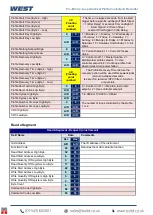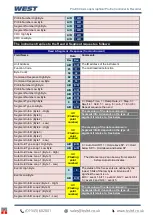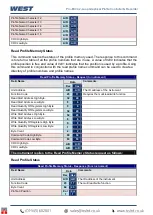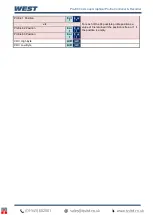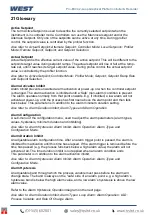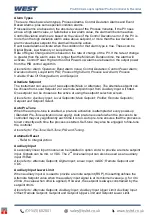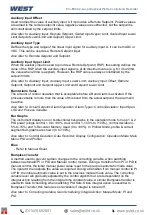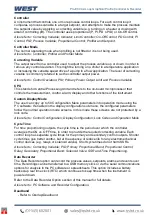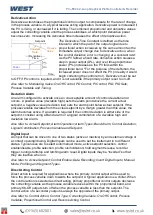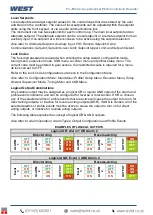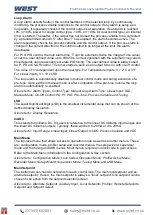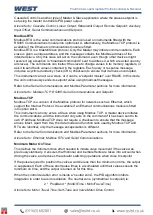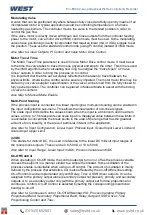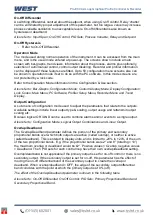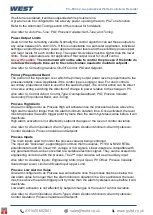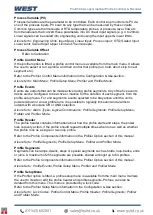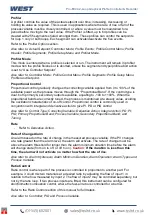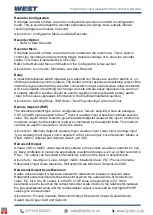
Pro-EC44 2-Loop Graphical Profile Controller & Recorder
Pro-EC44 Product Manual - 59540-2 September 2014
Page 212
Derivative
Time
Constant
Rate
Setpoint
Power
Process
Value
Time
Derivative Action
Derivative action biases the proportional control output to compensate for the rate of change
in the process variable. In a typical reverse acting application, derivative power is increased if
the PV is rising, or decreased if it is falling. The combined proportional and derivative values
adjust the correcting variable until the process stabilises, at which point derivative power
becomes zero. Increasing the derivative time increases the effect of derivative action.
The Derivative Time Constant is defined as the time
interval in which the part of the output signal due to
proportional action increases by the same amount as the
immediate output change due to derivative action, when
the control deviation error is changing at a constant rate*
.
As the PV falls at a fixed rate, derivative action causes a
step in power output (D%), and over time proportional
power (P%) increases as the PV falls within the
proportional band. *For the purpose of the definition, the
increased power does not affect the PV (in reality it would
begin correcting the control error). Derivative must be set
to OFF if PI control is required, and it is not available if the primary output is set to on-off.
Also refer to: Modulating Valve; On-Off Control; PD Control; PI Control; PID; PID Sets;
Process Variable and Tuning.
Deviation Alarm
An alarm configured to activate once an unacceptable amount of control deviation error
occurs. A positive value (deviation high) sets the alarm point above the current actual
setpoint, a negative value (deviation low) sets the alarm point below actual setpoint. If the
process variable deviates from the actual setpoint by a margin greater than this value, the
alarm becomes active. If an alarm is required if the control deviation is either side of the
setpoint, consider using a Band alarm or a logical combination of a deviation high and
deviation low alarm.
Also refer to: Actual Setpoint; Alarm Operation; Alarm Types; Band Alarm; Control Deviation;
Logical Combination; Process Variable and Setpoint.
Digital Input
An input that can be driven to one of two states (active or inactive) by and external voltage or
a contact opening/closing. Digital Inputs can be used to set the instrument in to different
states. Typical uses are to select auto/manual mode, active setpoint selection, control
enable/disable, profile selection, profile run/hold/abort, hold segment release, recorder
trigger, tuning start/stop and latching alarm reset.
Digital inputs may be “inverted” so that
they are inactive when on.
Also refer to: Active Setpoint; Control Enable; Data Recording; Invert Digital Inputs; Manual
Mode; Profiling and Segment Types.
Direct Acting Control
Direct action is required for applications where the primary control output will be used to
force the process variable down towards the setpoint. A typical application is a chiller. When
the control action is selected as direct acting, primary proportional control outputs decrease
the correcting variable as the process variable reduces within the proportional band, and
primary On-Off outputs turn off when the process variable is less than the setpoint. The
control action of a secondary output is always the opposite of the primary output.
Also refer to: Control Action; Control Type; Correcting Variable; On-Off Control; Process
Variable; Proportional Control and Reverse Acting Control.
Summary of Contents for Pro-EC44
Page 1: ...Pro EC44 2 Loop Graphical Profile Controller Recorder Pro EC44 User Guide 59540 2 ...
Page 2: ......
Page 6: ......

